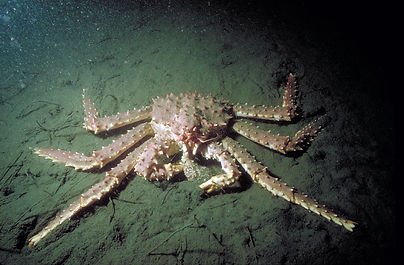
Imagine the underwater world as a bustling market, where king crabs roam the aisles, searching for the freshest offerings. They’re opportunistic hunters and scavengers, adapting their diets based on what’s available. Just like a picky eater at a buffet, they have preferences, but they’ll also take what they can get. This flexibility helps them thrive in various environments, from freezing Arctic waters to the shores of Alaska.
Now, let’s explore the intriguing world of king crab diets and feeding habits, so you can appreciate these ocean dwellers beyond just their delicious taste.
What Do King Crabs Eat?
King crabs are known for being omnivorous, meaning they enjoy a mixed diet. Generally, their meals consist of both plant and animal matter. You might be wondering what that looks like in practice. Well, here’s the rundown:
- Meat: King crabs feast on fish, mollusks, and other crustaceans. They’ll scavenge the ocean floor for any leftovers, making them quite efficient eaters.
- Algae and Detritus: They also munch on various types of marine algae and detritus, which is decomposing plant and animal matter. This helps them maintain a balanced diet.
- Small Invertebrates: Occasionally, they will gobble up small invertebrates like sea urchins or worms, supplementing their protein intake.
The king crab’s diet is dictated by age, environment, and availability of food sources. Younger crabs tend to eat more algae since they’re often found in shallower waters, where plants are more abundant. As they mature, their diet transitions to more animal protein as they venture into deeper waters.
Feeding Behavior of King Crabs
Feeding behavior in king crabs is as diverse as their diet. Picture them like savvy shoppers strategically browsing for food. They use their keen sense of smell to detect food sources from a distance, helping them pinpoint the best pickings.
One interesting aspect of their feeding is that king crabs are known to use their pincers for foraging. They’ll dig into the ocean floor, overturning rocks and sand in search of hidden delicacies. This behavior not only reveals their instincts but also plays a crucial role in the ecosystem by redistributing nutrients.
Another fascinating behavior is their scavenging nature. If a king crab stumbles upon a dead fish or any other organic matter, it won’t hesitate to take advantage of the opportunity. This adaptability not only helps them survive but also keeps the ocean’s food web balanced.
Seasonal Variations in Diet
Like many creatures in nature, the diet of king crabs can change with the seasons. Imagine a buffet that changes its menu throughout the year. During warmer months, they might have a wider variety of food options due to increased biological activity in the water.
In spring and summer, plankton blooms appear, attracting various fish and invertebrates that king crabs thrive on. During these times, their diet can shift to include more fish as they actively hunt. As the weather gets colder, however, the availability of food can dwindle. King crabs may then rely more heavily on scavenging, looking for anything they can find on the ocean floor to sustain themselves.
This seasonal change isn’t just vital for their diet; it also impacts their growth and reproduction. A well-fed king crab is more likely to thrive and successfully reproduce, ensuring the continuation of their species.
Impact of Environment on Diet
The environment plays a significant role in determining the diet of king crabs. They can be found in various locations—from deep, icy waters to shallower coastal regions—and these habitats influence what and how they eat.
In deeper waters, where food is scarcer, king crabs may rely more on scavenging for dead organisms. In contrast, in shallower waters, they have access to a greater variety of algae and invertebrates. This distinction highlights how adaptable these creatures are in response to their surroundings.
You may also notice that factors like water temperature and salinity can affect the availability of food. For instance, during warmer months when the water temperature rises, there’s often an abundance of marine life. King crabs capitalize on these conditions, adjusting their feeding habits to maximize their nutritional intake.
Role of King Crabs in Their Ecosystem
King crabs are not just consumers; they play a vital role in their ecosystems. Think of them as clean-up crew members, helping to maintain balance in their underwater neighborhoods. By scavenging dead organisms, they prevent the buildup of debris on the ocean floor, promoting a healthier environment.
Additionally, their predation on smaller invertebrates helps control these populations, ensuring that no single species dominates the marine habitat. This balance is crucial for the overall health of the ecosystem, influencing everything from the plants that grow in the ocean to the larger fish that depend on a varied diet.
Their presence in the ecosystem also makes them significant for commercial fishing industries. People love king crab for its sweet, tender meat, meaning they are highly sought after by fishermen and seafood lovers alike. But managing their populations wisely is essential for sustainability.
By now, you have a clearer picture of what king crabs eat and how their feeding habits shape both their lives and the ocean ecosystem. These striking creatures are more than just a delicious seafood option; they’re integral players in the marine environment. Their diet is a testament to their adaptability and resilience, allowing them to thrive in varying conditions.
So, the next time you enjoy a king crab feast, think about the intricate world of their feeding habits that makes it all possible. From their omnivorous diet to their scavenging behaviors, king crabs truly are remarkable creatures deserving of our appreciation.
